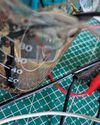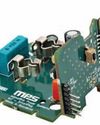SECURITY BUG IN ESP CHIPS! What Is It? How To Handle It?
Electronics For You
|April 2025
A hidden ESP32 feature could let attackers spoof devices, steal data, and install malware. With IoT security at stake, what does this mean for millions of connected devices?

Tarlogic Security has uncovered a hidden functionality in the ESP32, a widely used microcontroller that supports Wi-Fi and Bluetooth connectivity in millions of IoT devices. This undocumented feature, if exploited, could allow attackers to impersonate legitimate devices and install persistent malware on critical systems, including smartphones, computers, smart locks, and medical equipment. By bypassing standard code audit controls, malicious actors could potentially compromise sensitive devices at scale.
Cybercriminals could exploit these hidden commands to conduct impersonation or spoofing attacks. By creating fake Bluetooth devices that mimic legitimate ones, attackers could trick users into connecting, allowing them to intercept keystrokes, passwords, banking details, and personal messages. Beyond data theft, unauthorised remote control of devices is also a concern, with attackers potentially activating microphones or cameras unnoticed. The risk extends beyond smart-phones and laptops—digital door locks and medical devices could be compromised.
Espressif, the manufacturer of the ESP32, acknowledges the existence of these hidden commands but states that they are intended for debugging purposes. According to the company, these commands are part of the host controller interface (HCI) protocol used in Bluetooth communication and are typically used for internal testing. While debugging tools are standard in Bluetooth controllers, the presence of undocumented commands raises concerns about potential security risks and unauthorised access.
How to protect yourself from Bluetooth security risks
Backdoors and security flaws in Bluetooth devices can be exploited if not detected early. Conducting Bluetooth security audits is crucial to prevent potential threats.
- Use security tools.
यह कहानी Electronics For You के April 2025 संस्करण से ली गई है।
हजारों चुनिंदा प्रीमियम कहानियों और 10,000 से अधिक पत्रिकाओं और समाचार पत्रों तक पहुंचने के लिए मैगज़्टर गोल्ड की सदस्यता लें।
क्या आप पहले से ही ग्राहक हैं? साइन इन करें
Electronics For You से और कहानियाँ

Electronics For You
Tech Majors Are Racing TOWARDS NET-ZERO - What About You?
Apple, Microsoft, Amazon, Google, Infosys, Wipro—global and Indian firms are heading closer to achieving net-zero emissions, a mandate to combat climate change. Here is what you need to know to start your journey...
12 mins
December 2025

Electronics For You
Miniature IoT WATER TDS And LEVEL MONITOR Cum CONTROLLER
For setups that rely on stored water, clear awareness of tank level and water quality is essential.
3 mins
December 2025

Electronics For You
The Impact Of GENERATIVE AI On The Future Of AUTOMOTIVE AND EVs
Autonomous vehicles, connected ecosystems, and smart factories are only the beginning. Generative Al is pushing the auto industry beyond predictions into a bold era of creativity-from EV design to real-time diagnostics and showroom automation. Here is how GenAl is reshaping innovation across the automotive value chain.
8 mins
December 2025

Electronics For You
How AI Tools Are Making SOFTWARE DEVELOPMENT BETTER
AI is reshaping how we code, debug, and collaborate. From Copilot to automation, it is changing software development in ways worth exploring.
3 mins
December 2025
Electronics For You
How AI Tools Are Making SOFTWARE DEVELOPMENT BETTER
AI is reshaping how we code, debug, and collaborate. From Copilot to automation, it is changing software development in ways worth exploring.
3 mins
December 2025

Electronics For You
5 Interesting Reference Designs FOR SMART HOMES
Smart home devices are transforming the way people interact with their appliances. They make homes more convenient, secure, and energy-efficient. From smart plugs and energy monitors to smart locks and thermostats, reference designs help design engineers create connected products that are easy to use, consume less power, and are reliable. These designs allow you to control devices remotely, track energy use, extend battery life, and automate routines. They provide practical solutions for upgrading homes and small commercial spaces without major modifications.
3 mins
December 2025

Electronics For You
Fancy USB LED VASE
This USB LED vase is a simple yet elegant device that fuses art with electronics to create a decorative lighting display. Powered directly from a standard USB port, it uses readily available components such as MOSFETs, resistors, capacitors, and LEDs to produce a striking, dynamic sequence of lights.
3 mins
December 2025

Electronics For You
"WHAT OTHERS SELL IN FOUR BOXES WE BUILT IN ONE"
Years of custom field work are shaping a product line with its own cloud, its own hardware, and a market that is now beginning to recognise its value.
8 mins
December 2025

Electronics For You
BUILD LARGE LANGUAGE MODELS
Large language models are machine learning models designed for a range of language-related tasks such as text generation and translation. Here’s how open source software can help you build your own large language model.
6 mins
December 2025

Electronics For You
Rare Earth Or Rare Ingenuity? India Remains Between The Two
With China firmly controlling rare earth exports, India confronts a critical moment in its technological trajectory.
8 mins
December 2025
Listen
Translate
Change font size

